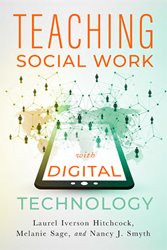Virtual Volunteering for Social Work Education during COVID19

Each semester, I teach courses with service learning requirements in our BSW program. As many of you know, service learning combines volunteer work with critical reflection so that students can make connections between real-life experiences and their academic course work. It is consider a high-impact educational practice in higher education and the pedagogical constructs embedded within service learning are a natural fit for social work education. Many undergraduate social work programs require volunteer hours for admission into their professional social work programs. At the University of Alabama at Birmingham (UAB), our students volunteer for 20 hours as part of a semester-long, one-credit hour lab course, which is connected to a practice course. While volunteering in community-based settings, our BSW students get experiences with different types of agencies, social problems, client populations, and activities that social workers do on a daily basis. Then, they bring these experiences back into the classroom to deepen their understanding of generalist social work practice with individuals, groups and organizations. Students take three service learning lab courses prior to their field semester, which gives them a grounding for what to expect during their field placement along with 60 hours of volunteer experience for their professional development and resume.
In March 2020, the COVID19 pandemic disrupted our lives and how we teach our courses. Within the span of a week, I had to shift over 100 students in our three service learning lab courses from doing in-person volunteering at five community locations in the Greater Birmingham area to doing virtual volunteer work. In this blog post, I want to share how I did this and offer resources for social work educators who also need virtual volunteer opportunities for their students.
Book Group Discussion Guide for Teaching Social Work with Digital Technology

Back in September, Melanie Sage, Nancy Smyth, and I announced a virtual book group for our work – Teaching Social Work with Digital Technology. The goals of the book group were to: 1) create a supportive learning community; and 2) provide space for reflection about one’s own professional development with teaching with technology. You can read more about this blog post:
Teaching Social Work with Digital Technology Book Group
We launched our book group in January and ended it in June 2020, with monthly meetings and a moderated online private Facebook group. The group included a monthly live virtual meeting with discussion moderated by the authors and guest facilitators. Live meetings allowed members to participate and ask questions. In between these live meetings, the facilitators led and moderated discussions about teaching with tech, offering reflective questions and simple learning tasks. Additionally, all live meetings were recorded and archived for later viewing in the group. We will leave the group up as an archive until the end of 2020. Please know that this group will no longer be moderated.
Overall, we had a total of 223 members in the group, and based on the group analytics there were over two hundred posts submitted, and a lot more members reviewing/reading the posts. Although we expected greater engagement, we know that this year brought unexpected challenges for all of us. We believe that good discussion prompts and questions from our facilitators promoted thoughtful reflection and engagement each month. We are sharing these questions and prompts here in this blog post so that others can use them for their own review or to start book groups in their institutions. Here is the discussion guide:
The unprecedented shift into teleworking; a personal story about working remotely in social work education
Editor’s Note: Agata Dera, MSW, is an Associate and LiveSupport Specialist with the Columbia School of Social Work’s (CSW) Online Campus, where she works with social work faculty and students in online courses to optimize the digital learning environment. In this post, she discussed how she transitioned from an office space to remote working. As many of us are working at home because of the COVID19 pandemic, Agata offers practical suggestions and encouragement to this new way of working for many social work professionals. You can connect with Agata on Twitter at @agataddera.

Over the past few weeks of this year, as the world stands together in the face of a pandemic, I have witnessed so many of my colleagues experience an unprecedented shift to working from home. As according to Forbes (Eisenberg, 2020), it is likely that more than half of our workforce is now working remotely, I cannot help but to reminisce of my transition into a virtual workforce. I hope that by sharing my story with you, you will have the insight I wish I once had to enhance your productivity and overall success.
For the past several years, I have been solely working from home due to severe health issues. Working remotely provided me with the flexibility I needed to be able to recover from several major spinal cord surgeries while also continuing my professional career. I truly believe that for me, being able to work from home is a blessing as my career is such a big part of my identity.
Fostering a spirit of collaboration with Social Work Students during the COVID-19 Pandemic
Editor’s note: When COVID19 cases started rising in the US in March 2020, institutions of higher education made significant decisions that required instructors and students to pivot the delivery and design of courses almost overnight. In this blog post, an instructional team from Columbia University’s School of Social Work (CSSW) detail how they approached changes to their course using trauma-informed teaching strategies. The team consists of Matthea Marquart, Director of CSSW’s Online MSW Program, Katherine Seibel, Legislative and Policy Analyst at a nonprofit promoting young people’s wellbeing, and Nicole Wong, Director of Support, Advocacy, & Violence Prevention at Vassar College. For more information related to this post, please reach out to Matthea at @MattheaMarquart.
Our spring semester online course, which is part of Columbia University School of Social Work’s (CSSW) Master’s of Science in Social Work program, began in March 2020, with our first class session on March 10. The next day, the World Health Organization declared COVID-19 a pandemic, and the next week was spring break. Columbia University, which is located in New York City, had already been taking steps to protect student safety, such as moving residential courses online, but our course was already online, with our students located across the United States.

As a result, the policy impact that most affected our course came with the University’s announcement on March 20 that all spring semester courses would be graded pass/fail. This policy impact freed us to make significant changes to our course assignments and grading policies mid-semester, in collaboration with each other as the instructional team, as well as with the students. We also implemented trauma-informed teaching strategies in response to the changing circumstances in the world, which had a significant impact on students and which we recognized could contribute to increased experiences of trauma. Trauma-informed teaching recognizes that past and ongoing trauma can impact current student success, and employs strategies to foster a supportive environment and reduce barriers to learning. An example is sharing power with students through collaboration and choice about course decisions.


